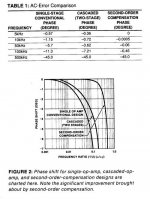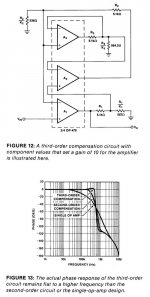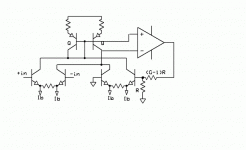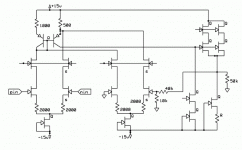Mr. Graham Maynard mentioned the importance of minimum phase shift (at 20khz being benchmark) for good sounding power amp. But he always use JLH topology.
I read this app note from Analog Device, the number is AN-107, title "Active Feedback Improves Amplifier Phase Accuracy". The "Active Feedback" here is using opamp, not like Scott Wurcer's thread.
In this app note, it shows that if we put 1 or 2 opamps in the feedback path, it can reduce phase shift dramatically, like in table 1 of the app note (from -5.7deg to -0.006deg at 50khz)
If this is the same thing with what Mr. Maynard saying, then this trick can be used to any power amp, not necessarily using JLH topology. Anyone has tried this? Does it making better sounding power amp?
PS. I have the copy of the AN-107, but the pdf is sized of 778kb, how to show it here?
I also wonder, why AN-107 disappears from Analog Device's website. Does this AN-107 defective/not working?
I read this app note from Analog Device, the number is AN-107, title "Active Feedback Improves Amplifier Phase Accuracy". The "Active Feedback" here is using opamp, not like Scott Wurcer's thread.
In this app note, it shows that if we put 1 or 2 opamps in the feedback path, it can reduce phase shift dramatically, like in table 1 of the app note (from -5.7deg to -0.006deg at 50khz)
If this is the same thing with what Mr. Maynard saying, then this trick can be used to any power amp, not necessarily using JLH topology. Anyone has tried this? Does it making better sounding power amp?
PS. I have the copy of the AN-107, but the pdf is sized of 778kb, how to show it here?
I also wonder, why AN-107 disappears from Analog Device's website. Does this AN-107 defective/not working?
For my experience, this parameter doesn't change by himself the audio performances. There are amp. "top" with very tall phase shift ( depends simply from the technique of internal compensation ).
I believe that the better audio quality in an encircled with little phase shift are creditable to the better distribution of the BW of gang in operation of the OPen loop gain.
Mauro
I believe that the better audio quality in an encircled with little phase shift are creditable to the better distribution of the BW of gang in operation of the OPen loop gain.
Mauro
Putting aside implications of more than a few deg phase shift at audio frequencies (and these are important implications regarding bandwidth and more complex issues if NFB is used), the proboem itself is not of phase shift as much as of it's linearity and repeatability between many, and at least two examples of the same amp.
Obviously, because in a stereo system there are at least two amplifiers, in order to have accurate stereo reproduction, both amps have to be as much as possible the same within the audio bandwidth, including phase shift. If a phenomenon is present naturally (as opposed to deliberate), tolerances of a parameter tend to be proportional to the magnitude of the parameter, and this includes phase shift.
It is exceedingly difficult to produce an amp with i.e. quickly increasing phase shift with frequency, where the relative phase shift between two such amps remains negligible (unless we are diong this deliberately, in which case, it's a filter not merely an amp!).
Therefore, the easyest way to ensure negligible phase DIFFERENCES between channels, is to ensure negligible phase shift of all channels by themselves. Otherwise you get phase differences between channels where they were not supposed to be. This very problem was the reason digital filtering and oversampling were introduced to digital audio, as phase shift differences between analog brick-wall filters proved themselves very (and anoyingly) audible. Of course, the problem is not nearly as pronounced in power amplifiers, but it does exist, and designers need to be aware of it.
Obviously, because in a stereo system there are at least two amplifiers, in order to have accurate stereo reproduction, both amps have to be as much as possible the same within the audio bandwidth, including phase shift. If a phenomenon is present naturally (as opposed to deliberate), tolerances of a parameter tend to be proportional to the magnitude of the parameter, and this includes phase shift.
It is exceedingly difficult to produce an amp with i.e. quickly increasing phase shift with frequency, where the relative phase shift between two such amps remains negligible (unless we are diong this deliberately, in which case, it's a filter not merely an amp!).
Therefore, the easyest way to ensure negligible phase DIFFERENCES between channels, is to ensure negligible phase shift of all channels by themselves. Otherwise you get phase differences between channels where they were not supposed to be. This very problem was the reason digital filtering and oversampling were introduced to digital audio, as phase shift differences between analog brick-wall filters proved themselves very (and anoyingly) audible. Of course, the problem is not nearly as pronounced in power amplifiers, but it does exist, and designers need to be aware of it.
And how does it affect transient response? In my opinion, a more important factor than phase shift good damping. If reducing phase shift causes ringing then I would go with the higher phase shift myself.
And how does it affect transient response? In my opinion, a more important factor than phase shift good damping. If reducing phase shift causes ringing then I would go with the higher phase shift myself.
hi, EVIL
I think current feedback amplifier also has less phase shift at high frequencies. what are your thoughts??
regards,
Kanwar
Hi,
I am not familiar with the appnote, but I have somewhere copy of magazine article coping with the same thematic. IIRC, prerequisite is that all opamps have their phase characteristic matched, so you must use quad opamp package for that. I doubt it will work with different amps.
Best regards,
Jaka Racman
I am not familiar with the appnote, but I have somewhere copy of magazine article coping with the same thematic. IIRC, prerequisite is that all opamps have their phase characteristic matched, so you must use quad opamp package for that. I doubt it will work with different amps.
Best regards,
Jaka Racman
Hi, Jaka,
You are very familiar with classD. I read somewhere that classD can reach 20deg shift at 20khz, is this true?
You are very familiar with classD. I read somewhere that classD can reach 20deg shift at 20khz, is this true?
Hi lumanauw
nice to see another 'hard question' of yours, that's what I like you for.😉
in my view 2nd order compensation is asking for problems, because it makes phase shift of close to 180deg. at high freqs. which can result in oscilation/ringing problems. To compare 1st order never shifts over 90deg. which makes more phase margin.
I think that good approach may be 2nd order pole-zero compensation. Than you should know 'natural' poles produced by amp to know where to place zero. Very hard for DIYing, needs thorougth measurements of open-loop poles. I think John Curl once mentoned making a pre-amp with 2nd order comp.
Agreed?
best regards
nice to see another 'hard question' of yours, that's what I like you for.😉
in my view 2nd order compensation is asking for problems, because it makes phase shift of close to 180deg. at high freqs. which can result in oscilation/ringing problems. To compare 1st order never shifts over 90deg. which makes more phase margin.
I think that good approach may be 2nd order pole-zero compensation. Than you should know 'natural' poles produced by amp to know where to place zero. Very hard for DIYing, needs thorougth measurements of open-loop poles. I think John Curl once mentoned making a pre-amp with 2nd order comp.
Agreed?
best regards
Hi lumanauw,
it is possible even with class D. Prime class D candidates for this are:
-filterless class D using three state (class BD modulation) such as TI TPA3001
-self oscillating classD taking post filter feedback (like UcD and Leapfrog)
-any class D with underdamped output filter (bad solution)
Best regards,
Jaka Racman
it is possible even with class D. Prime class D candidates for this are:
-filterless class D using three state (class BD modulation) such as TI TPA3001
-self oscillating classD taking post filter feedback (like UcD and Leapfrog)
-any class D with underdamped output filter (bad solution)
Best regards,
Jaka Racman
Agreed?
I dont know what to say, agree or not agree, because I don't understand this 😀
2nd order compensation is asking for problems
Very possible, the app note is now disappears from Analog Design's website.
think that good approach may be 2nd order pole-zero compensation. Than you should know 'natural' poles produced by amp to know where to place zero. Very hard for DIYing, needs thorougth measurements of open-loop poles. I think John Curl once mentoned making a pre-amp with 2nd order comp.
Aha............. So phase shift contributes to very good sounding amps/preamps. Yes, I remember JC is making a "difficult to make" preamp, but good sounding. Could this aspect is taken into that design?
it is possible even with class D. Prime class D candidates for this are:
I hear classD sounds a little "different" than analog amp. AKSA mentioned something to me about it.
Since the phase shift at 20khz is so big (could up to 20deg), is it possible that this phase shift contributes to the "typical" sound of classD (compared to analog amp)?
If classD could be made minimal phase shift with this method, could it sounds like analog amps?
I like the idea of current amplifiers because they obviate a lot of problems inherent in loudspeakers. However, contemporary speakers are all designed to work with voltage amplifiers, so results with current amplifiers can be less than perfect.Workhorse said:
hi, EVIL
I think current feedback amplifier also has less phase shift at high frequencies. what are your thoughts??
regards,
Kanwar
lumanauw, is "active compensation" the thread topic?
Your 1st circuits are “active compensation” amplifiers, the phase shift of the 2nd (hopefully identical op amp running at the same gain) is “inverted” by the feedback connection and subtracts from the outer op amps’ phase shift, when they are the same the phase shift is largely cancelled, these are sometimes called “0 second derivative” amplifiers – not the same as 2-pole or 2nd order compensation of a multistage amplifier
Active compensation is limited by how well the op amps match – something the manufacturers don’t tell you and which can be changed by load on the output op amp not seen by the compensating inner feedback op amp, and they are difficult to use at lower gains where 2nd poles in real op amp transfer functions limit loop stability
Active phase compensation of op amp circuits relying on matching of op amp transfer functions were explored when op amp capabilities were more limited – I don’t believe they have much utility in audio today when 10 MHz GBW is the low end of the scale for quality op amps
Even a 1 MHz 1st order roll off (closed loop gain 10x with 10 MHz GBW) has a time constant of only 159 nS and looks like ~ 50 um (0.002 inch for us US anachronists) of sound propagation path difference delay at audio frequencies
The generally accepted minimum perceptible time difference is 10 uS interaural delay with headphones; converting to phase shift 10 uS ~= 70 degrees @ 20 KHz, so I don’t get so excited about 1 degree @ 20 KHz
Smooth frequency dependent phase shifts that are common to both channels are much harder to hear ~10x
Which is a good thing for to listening multi driver dynamic loudspeakers; how likely are you to find that < 3 mm 10 uS interaural path difference “sweet spot” in your comfy chair a few meters from your speakers – how about using those pointy cones between your skull and the vise jaws to fix your head position relative to your speakers? – and for heaven’s sake don’t play more than one frequency at a time – even in the best case where the 2 tones are radiating from the same driver Doppler IM can be a bigger phase error contribution than any reasonable solid state amplifier
Your 1st circuits are “active compensation” amplifiers, the phase shift of the 2nd (hopefully identical op amp running at the same gain) is “inverted” by the feedback connection and subtracts from the outer op amps’ phase shift, when they are the same the phase shift is largely cancelled, these are sometimes called “0 second derivative” amplifiers – not the same as 2-pole or 2nd order compensation of a multistage amplifier
Active compensation is limited by how well the op amps match – something the manufacturers don’t tell you and which can be changed by load on the output op amp not seen by the compensating inner feedback op amp, and they are difficult to use at lower gains where 2nd poles in real op amp transfer functions limit loop stability
Active phase compensation of op amp circuits relying on matching of op amp transfer functions were explored when op amp capabilities were more limited – I don’t believe they have much utility in audio today when 10 MHz GBW is the low end of the scale for quality op amps
Even a 1 MHz 1st order roll off (closed loop gain 10x with 10 MHz GBW) has a time constant of only 159 nS and looks like ~ 50 um (0.002 inch for us US anachronists) of sound propagation path difference delay at audio frequencies
The generally accepted minimum perceptible time difference is 10 uS interaural delay with headphones; converting to phase shift 10 uS ~= 70 degrees @ 20 KHz, so I don’t get so excited about 1 degree @ 20 KHz
Smooth frequency dependent phase shifts that are common to both channels are much harder to hear ~10x
Which is a good thing for to listening multi driver dynamic loudspeakers; how likely are you to find that < 3 mm 10 uS interaural path difference “sweet spot” in your comfy chair a few meters from your speakers – how about using those pointy cones between your skull and the vise jaws to fix your head position relative to your speakers? – and for heaven’s sake don’t play more than one frequency at a time – even in the best case where the 2 tones are radiating from the same driver Doppler IM can be a bigger phase error contribution than any reasonable solid state amplifier
Hi lumanauw,
I think jcx's answer pretty much sums it up, but since you asked about class D (where very good amps have phase shift less than 20degrees, usually it is higher), here is the answer from a much more knowledgeable guy.
Best regards
Jaka Racman
I think jcx's answer pretty much sums it up, but since you asked about class D (where very good amps have phase shift less than 20degrees, usually it is higher), here is the answer from a much more knowledgeable guy.
Best regards
Jaka Racman
From what i have learned, phaseshift itself is not evil, just take care
that it is not dynamic, and that the delay keeps constant over the
whole audioband, and is not signaldependent.
The easiest way to achieve this seems to keep openloopfreqresponse
flat over the audioband.
A circuit having dynamic phaseshifts asks for problems with the feedbackloop...
I tried to achieve lowest possible phaseshifts for a long time, and now
my best sounding amp is some simple highgain amplifier, just having
flat freqresponse in openloop...
Mike
that it is not dynamic, and that the delay keeps constant over the
whole audioband, and is not signaldependent.
The easiest way to achieve this seems to keep openloopfreqresponse
flat over the audioband.
A circuit having dynamic phaseshifts asks for problems with the feedbackloop...
I tried to achieve lowest possible phaseshifts for a long time, and now
my best sounding amp is some simple highgain amplifier, just having
flat freqresponse in openloop...
Mike
At first it's about AN-107, what is it for, and why I never see it in power amp design?lumanauw, is "active compensation" the thread topic?
- Status
- Not open for further replies.
- Home
- Amplifiers
- Solid State
- Phase Accuracy




